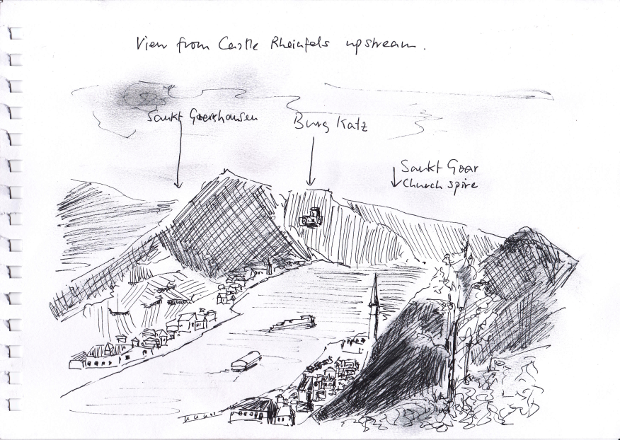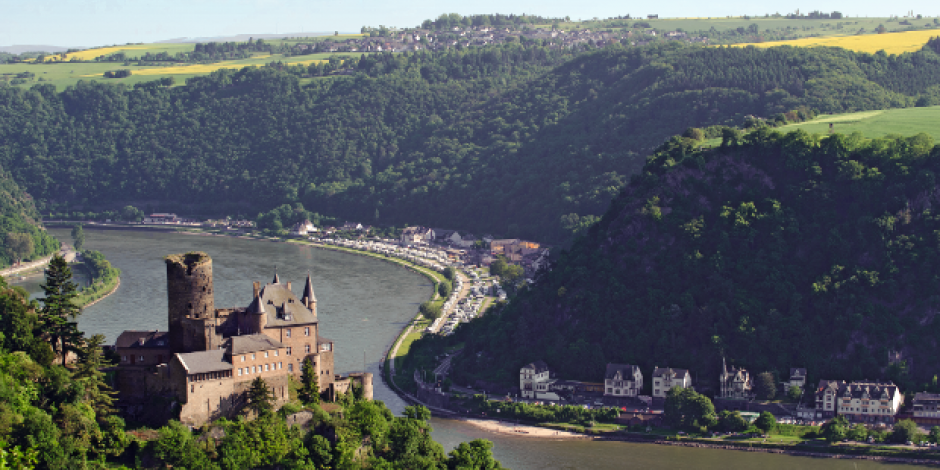to napein Nickerchen machenWas J. M. W. Turner (1775–1851) the greatest English artist of all time? I belong to those people who believe he was, and I rarely miss an opportunity to look at his work in London’s Tate Gallery, standing in front of paintings that seem to to dissolvesich auflösen, zerfließendissolve into mysterious and powerful harmonies.
It was with great delight, therefore, that I read about plans for a Turner Route marking the places where Turner had stood and to sketchSkizzen entwerfensketched in the summer of 1817. Specifically, the Turner Route, winner of the 2018 German Design Award (www.turner-route.de) in the categories of communication design and “signageBeschilderungsignage and wayfinding”, marks 26 spots between Koblenz and Bingen where the great artist gathered inspiration for paintings later completed back in England. This was Turner’s first major trip to Europe, and it laid the foundation for some of his most memorable work. On a recent grey day, I to set outsich auf den Weg machen, aufbrechenset out with my dog to see if I could see what he had seen.
Turner was 42 in the summer of 1817. He had been briefly to Switzerland and France in 1802. But continental travel had become difficult. In the early 19th century, Napoleon conquered 16 of the many small (and a couple of the larger) German states and founded the Confederation of the Rhine in 1806. More than eight million Germans lived in this area which was more or less ruled by France. The British were not allowed to travel there. It was not until Napoleon’s defeat at the Battle of Waterloo in June 1815 that “the continent” was opened up to tourists again.
One of the more popular travel destinations was, in fact, the site of the Battle of Waterloo, just outside Brussels. Turner’s guidebook on his 1817 trip was Charles Campbell’s The Travellers Complete Guide through Belgium and Holland ... with a Sketch of a Tour in Germany. It had been recently republished — to include a visit to Waterloo.
It wasn’t just this fascination with Napoleon that brought Turner to Europe, however. Ties between England and Germany were much closer back then than we imagine today. Until 1837, the king of England was also the king of Hanover, and had been since George I to inheriterbeninherited the English throne from Queen Anne in 1714. George III was king when Turner was born in 1775. He was the first of the Hanoverian kings to speak English like an Englishman, but even he married a German cousin. George III’s four elder sons also married German princesses.
Ties were close, not only in battle (at Waterloo), but in other areas, as well. The German architects Leo von Klenze and Karl Friedrich Schinkel were honoraryEhren-honorary members of the Institute of British Architects. The English poets Wordsworth and Coleridge travelled in Germany, learned German and read Goethe and Schiller. Most important of all, Lord Byron’s epic poemEposepic poem Childe Harold’s Pilgrimage, published between 1812 and 1818, popularized the romantic Rhine Valley and attracted large numbers of British tourists.
After visiting Waterloo, Turner moved on to Germany. He reached Cologne on 18 August 1817, and from there, he progressed on foot down the Rhine Valley. He was carrying a sort of early backpack, or satchelUmhängetaschesatchel, that contained his guidebook, an umbrella, clothes and shaving utensils as well as his painting and sketching materials, including three leather-bound sketchbooks: one small and two larger.
As he walked south, often along the Route Napoleon on the west bankhier: Uferbank of the Rhine, he sketched scenes in Cologne, Bad Godesberg and the Seven Hills, or Siebengebirge, mostly in his small Waterloo and Rhine sketchbook. It was when he got to the more dramatic scenery south of Bonn that he began working in the larger Rhine sketchbook and drew more complex compositions.
On the evening of 21 August 1817, Turner reached Koblenz, where he spent one day, fascinated by the great military fortress of Ehrenbreitstein. On 23 August, he set out again southwards, and this is where I join him.
En route
The Turner Route, developed in cooperation with the local artist Dr Armin Thommes, is in the process of being to implementrealisierenimplemented by the Zweckverband Welterbe Oberes Mittelrheintal (World Heritage Association of the Upper Middle Rhine Valley). So far, only four of the planned bronze site stones, complete with a QR code linking the visitor to the Turner painting in question, have been set in and around St Goar and St Goarshausen. However, the website already provides a well-researched guide to all the places on that part of Turner’s itineraryReiserouteitinerary, including GPS codes for each site. So I have no difficulty finding the second of the sites on the Turner Route.
Leaving Koblenz, he walked along the Rhine to what is today (and probably was in 1817) a small patchFleckpatch of rough grass. The painting that he later created based on what he saw is called The Junction of the Lahn and the Rhine. It shows the smaller River Lahn to sweephier: strömensweeping into its majestic cousin from the west. It is watched over by two castles (Stolzenfels and Lahneck) situated opposite each other on steep hills. I can see these two castles, although the hills are not as high as Turner to suggestsuggerierensuggests. But I cannot see the River Lahn. I check on the car’s navigation system. The Zusammenflussjunctionjunction is out of sight, just around a bendKurve, hier: (Fluss)Biegungbend in the Rhine. And the River Lahn flows in from the east, not the west.
Poetry and Truth (Dichtung und Wahrheit) was the title of the autobiography that Johann Wolfgang von Goethe began publishing between 1811 and 1814. The title suggests that there is a poetic process of selection when narrativeErzählung, Geschichtenarratives are written — even autobiographies. This selection emphasizes certain elements and ignores others. It was a popular notionGedanke, Ideenotion in the era of Romantic poetry and painting. Although we have no way of knowing whether Turner just forgot about geographical facts or deliberately chose to change them, I rather like the idea of a creative genius painting not only what he saw, but what he wanted to see.
In the artist’s footsteps
I drive southwards, to tick offabhakenticking off the points where Turner stood on 23 August 1817. Here is Lahnstein, followed by Boppard, Hirzenach and St Goar, with one castle after another coming into view on the east and west banks of the Rhine. Even on a grey day, the views are stunningatemberaubendstunning. Again and again, I compare Turner’s paintings with what I see in life. Every time, I notice small differences. The height of a hill, the steepness of a slopeHang, Abhangslope or the outlines of a distant town — it’s all there, but all slightly different (and not only because cars have replaced coaches).
When Turner reached Sankt Goar on the evening of 23 August, he was so enchantedbezaubert, entzücktenchanted with the small town that he spent a whole day there, resting and sketching. Many of his drawings show views from Castle Rheinfels — or views of the castle itself — and it’s here that I bring my day of “foot-stepping” Turner to an end.

Sitting in a small alcoveNischealcove in the castle restaurant with my dog to napein Nickerchen machennapping at my feet, I find spread out below me almost exactly the same view that Turner had had, overlooking the town of St Goar with its pointedspitzpointed church tower. I get out my own sketchbook and imagine that I’m seeing this for the first time. The Koblenz Castle Katz (Burg Katz) overlooking the Rhine near the town of St Goarshausen The Mouse Tower (Mäuseturm) outside the town of Bingen am Rhein Some of the 26 points that make up the William Turner Route along the Rhine Brauchbach Boppard St Goarshausen St Goar Oberwesel Lorch Trechtingshausen Bingen things that are important (the river, hills, sky, settlement and a distant castle) come sharply into focus. And after that, rather like Turner, I let my imagination to smudgeverwischensmudge a few details.
The Turner Route continues south as far as Bingen, which is where the spectacular scenery turns into softer hills and a wider river dottedübersät, mit viel(en)dotted with islands. This is where Turner got on a boat, going as far as Mainz before returning to Cologne and then England. Using his sketches, he spent the months of September to November 1817 painting a series of 51 watercolours that he sold immediately to his friend and patronMäzen, Fördererpatron Walter Fawkes for about £500.
The Turner scholarGelehrte(r), Experte, Expertinscholar Cecilia Powell writes of these watercolours that they “would have gained Turner a worldwide reputation even if he had died in 1818”. Luckily for art lovers all over the world, the painter lived for another 34 years and returned several times to Germany. It’s these first views of the Rhine that many love most, however. They are filled with wonder, freshness and mystery: a powerful combination that only great art can achieve, but everybody can appreciate. Thanks to these paintings, it’s not “goodbye”, but definitely “Auf Wiedersehen”.
Neugierig auf mehr?
Dann nutzen Sie die Möglichkeit und stellen Sie sich Ihr optimales Abo ganz nach Ihren Wünschen zusammen.



